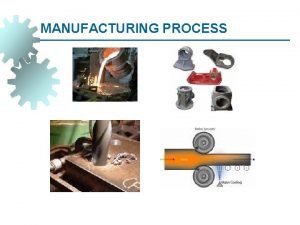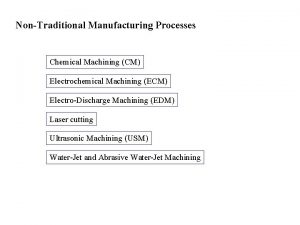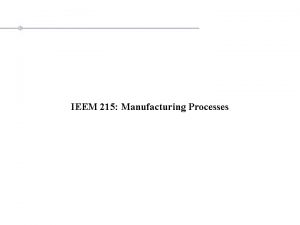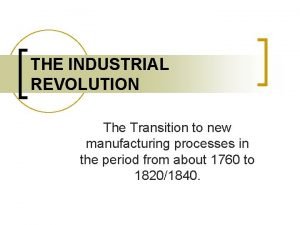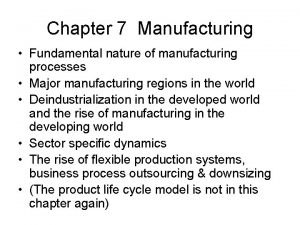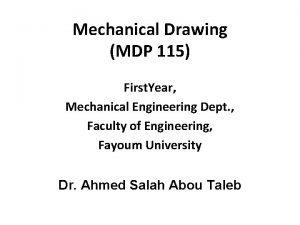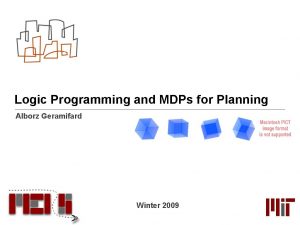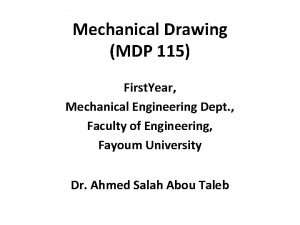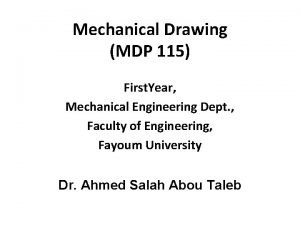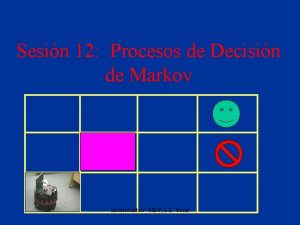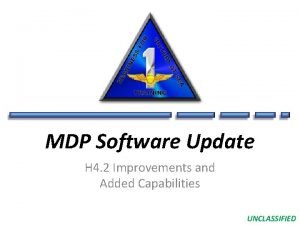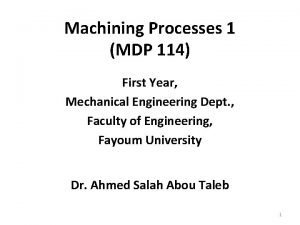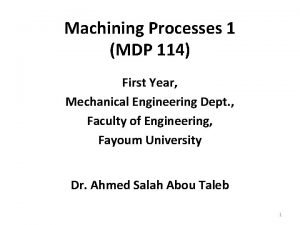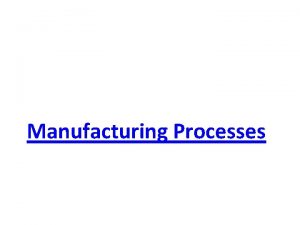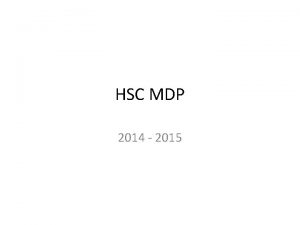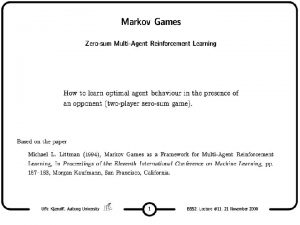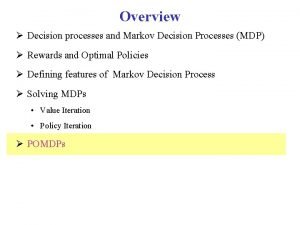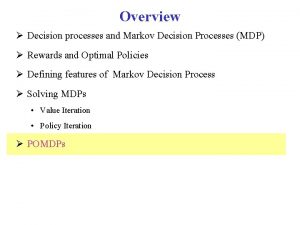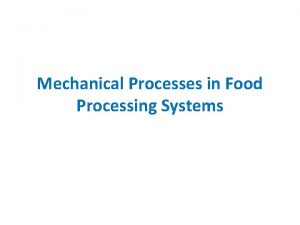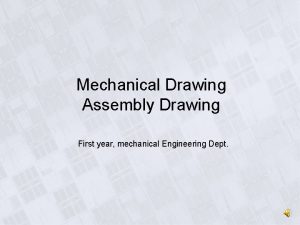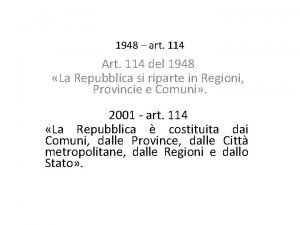Manufacturing Processes 1 MDP 114 First Year Mechanical


























- Slides: 26

Manufacturing Processes 1 (MDP 114) First Year, Mechanical Engineering Dept. , Faculty of Engineering, Fayoum University Dr. Ahmed Salah Abou Taleb 1

Machining Operations & Machine Tools Turning Planner Milling Gears Drilling Machine Screw Thread Shaper Saw Broacher 2

Milling Machine 3

Definition Machining operation in which work is fed past a rotating tool with multiple cutting edges. • Axis of tool rotation is perpendicular to feed direction. • Creates a planar surface; other geometries possible either by cutter path or shape. • Other factors and terms: • Milling is an interrupted cutting operation. • Cutting tool called a milling cutter, cutting edges called teeth. • Machine tool called a milling machine. 4

Milling Machine Horizontal Vertical Ram 5

Milling Machine (a) horizontal milling machine 6

Milling Machine (b) vertical milling machine 7

Milling Machine (b) ram type machine; ram can be adjusted in and out, and tool head can be swiveled 8

Forms of Milling Two forms of milling: (a) peripheral milling, and (b) face milling 9

Peripheral Milling vs. Face Milling Peripheral milling: ü Cutter axis is parallel to surface being machined. ü Cutting edges on outside periphery of cutter. Face milling: üCutter axis is perpendicular to surface being milled. üCutting edges on both the end and outside periphery of the cutter. 10

Milling Operations Slab Milling: The basic form of peripheral milling in which the cutter width extends beyond the workpiece on both sides 11

Milling Operations Conventional Face Milling: Cutter overhangs work on both sides 12

Milling Operations Slotting: Width of cutter is less than workpiece width, creating a slot in the work 13

Milling Operations End Milling : Cutter diameter is less than work width, so a slot is cut into part 14

Milling Operations Profile Milling : Form of end milling in which the outside periphery of a flat part is cut 15

Milling Operations Pocket Milling: Another form of end milling used to mill shallow pockets into flat parts 16

Milling Operations Surface Contouring : Ball‑nose cutter is fed back and forth across the work along a curvilinear path at close intervals to create a three dimensional surface form 17

Milling Operations Drilling: Creates a round hole in a workpart. Cutting tool is called a drill or drill bit. Customarily performed on a drill press, but can be done on a vertical mill and on a lathe. 18

Milling Operations Reaming: Used to slightly enlarge a hole, provide better tolerance on diameter, and improve surface finish. 19

Milling Operations Tapping: Used to provide internal screw threads on an existing hole. The tool is called a tap 20

Milling Operations Counterboring: Provides a stepped hole, in which a larger diameter follows a smaller diameter partially into the hole 21

Cutters for Different Types of Milling Cutters for (a) Straddle Milling, (b) form milling, (c) slotting, and (d) slitting with a milling cutter. 22

Cutters for Different Types of Milling (a) T-slot cutting with a milling cutter. (b) A shell mill. 23

Milling Cutting Tools 24

Machining Calculations • Cutting (Spindle) Speed: v = cutting speed, D = cutter diameter • Feed Rate: (mm/min) f = feed per tooth , nt = number of teeth • Material Removal Rate w = width, rpm (mm 3/min) d = depth of cut 25

Machining Calculations • Machining Time: – Slab Milling: L = length of cut, (min) d = depth of cut – Face Milling: • For single pass: • For multi-passes: w = width of cut 26
 ( 299 587 114 0 0 ) | ( 299 587 114 0 )
( 299 587 114 0 0 ) | ( 299 587 114 0 ) Manufacturing cost vs non manufacturing cost
Manufacturing cost vs non manufacturing cost Process vs job costing
Process vs job costing Cost concept and classification
Cost concept and classification Manufacturing cost vs non manufacturing cost
Manufacturing cost vs non manufacturing cost Additive manufacturing vs subtractive manufacturing
Additive manufacturing vs subtractive manufacturing Manufacturing processes for engineering materials 5th
Manufacturing processes for engineering materials 5th Classification of production system
Classification of production system List of manufacturing processes
List of manufacturing processes Composite manufacturing process
Composite manufacturing process Nontraditional manufacturing processes
Nontraditional manufacturing processes Traditional manufacturing processes
Traditional manufacturing processes Industrial revolution transition
Industrial revolution transition Nature of manufacturing process
Nature of manufacturing process Concurrent processes are processes that
Concurrent processes are processes that Mdp drawing
Mdp drawing Mdp
Mdp Wharton risk management and decision processes center
Wharton risk management and decision processes center Mdp drawing
Mdp drawing Mdp drawing
Mdp drawing Mdp
Mdp Mdp and mrp examples
Mdp and mrp examples Mdp example
Mdp example Mdp
Mdp Mdp example
Mdp example Software mdp 2017
Software mdp 2017 Mdp
Mdp







